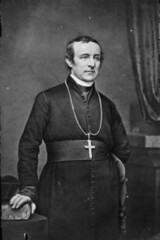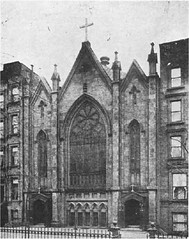From The Peopling of New York City
Contents |
Overview
Religion was integral part of the German identity. The incoming immigrants can be generally split into two groups: Catholics and Lutherans, with a small portion being other Protestant sects as well as free thinkers.
Catholic Germans
The Catholic Germans were the minority among the general German populations. However they had the easiest time integrating themselves into the general hierarchy of New York. Since the organized Catholic Church was led and staffed by Irish ministers the wishes of German Catholics generally went unanswered. The Irish Archbishop John Hughes did not care much for his new parishioners. As such, German Catholics were left to fend for themselves. The biggest issue facing the German believers was the lack of German language based sermons in their local churches.[1] The demand for such sermons grew because of the influx of new immigrants and because of the growing anti-assimilation mentality within the German population. The first sermons in German were held in basements of English-based churches. It soon became apparent that such conditions could not continue: the Germans needed a church to call their own. Since the Catholic hierarchy of New York turned a blind eye to the problems of the non-Irish believers, the Catholic Germans were forced to look for support within the community. Reverend Johann Stephen Raffeiner, a man of considerable wealth, was the founder of one of the first German parishes in New York. In subsequent years he traveled around the boroughs establishing German churches with his own funds and trained priests along the way. After his eventual death the parish fell into disarray with unskilled priests taking over.
Growth in Power
Over time the power of the German churches grew as the size of the congregation swelled to ever new heights. Eventually, even Archbishop Hughes could not ignore the Germans. In particular, the Holy Trinity Church remained the strongest church in New York until the early 1900's. The strength of the church was fueled and channeled by the German Catholic newspapers such as Katholische Kirchenzeitung and Die Aurora. This new found power culminated in the formation for the helping hand organization known as the German Verein led by John Riordan. The organization existed as a means to help the incoming German immigrants with the matters of faith as well employment and lodgings. They had an outpost as Castle Garden, the landing point of the immigrants. The conversions at Castle Garden further increased the size of the German congregation, thereby increasing the power of the Verein. This caused enormous friction between the Archbishop Hughes and the Verein leaders which remained unresolved until the eventual loss of influence by the church.
Protestant Germans
A minority among the German population, the Protestant believers were nonetheless influential within the German community. Most of the Protestant Germans belong to the Lutheran sect with a very minor fraction identifying themselves as Calvinist. Unlike the German Catholics the Protestants were made up of many nationalities of the Holy Roman Empire prior to the German unification. The Protestants had a much harder time fitting into the New York system of faith. Similarly to the Catholics, the Protestants were left to establish their own churches without the support of the larger congregations. Because the Protestants had no fixed hierarchy within New York it made friction between churches inevitable. Pastor Friedrich Wilhelm Tobias Steimle was the leader of one of the first Lutheran churches. He was extremely overbearing and had issues with the established authority. He was highly anti-assimilation, even more than the average German. His first congregation met in a beer hall and eventually swelled until the small building could no longer contain it. With the money donated by his congregation he was able to by a church and move his parish there.[2] As his congregation grew so did his power. Eventually his method of preaching came into direct conflict with the Protestant Ministerium in New York. He split off to form his own synod, which lasted for 6 years. In the meantime the established Dutch Reformed Church gained power with particular effectiveness in Astoria and College point with the help of Conrad Poppenhusen and William Steinway. They established a mission in Castle Garden a continued to expand their congregation.
Free Thinkers and Agnostics
A small number of Germans that immigrated to the U.S. were considered free thinkers or agnostics. They did not generally consider themselves to be a part of a religious group. These individuals were considered to be the most active in the abolitionist cause.



